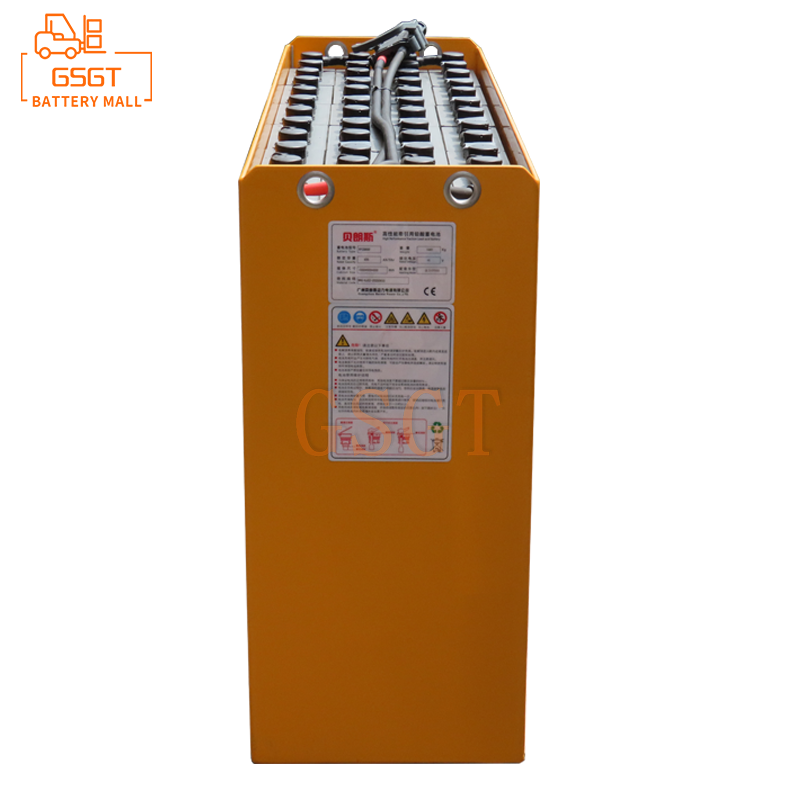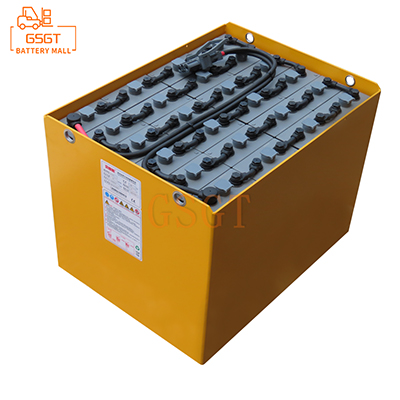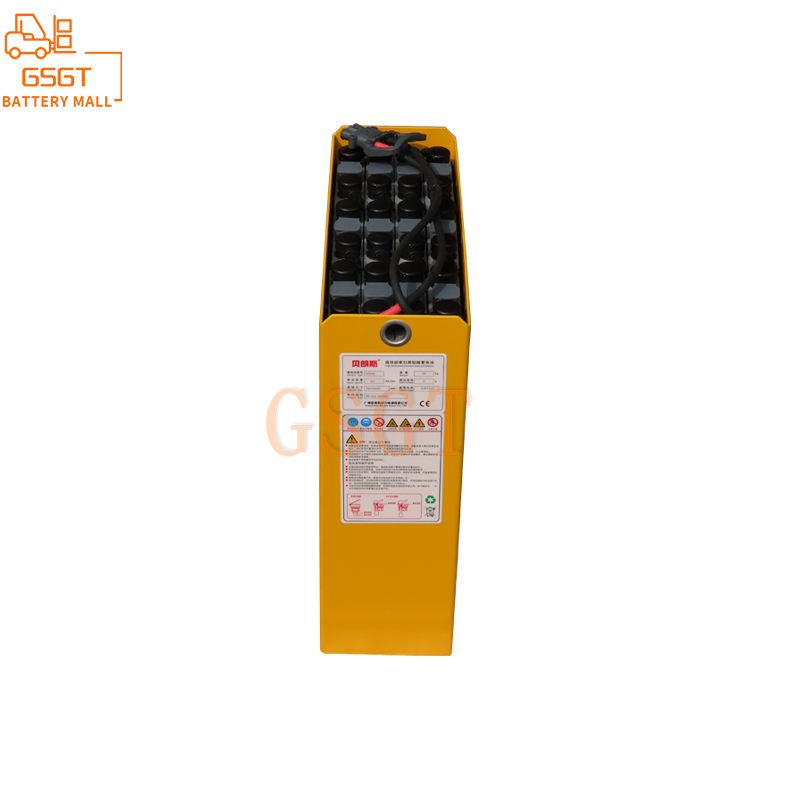Time:2025-04-25 12:44:08
Browse:632
In the modern logistics and warehousing industry, forklifts, as key handling equipment, their operational efficiency directly affects the operational effectiveness of the entire logistics system. Lead-acid batteries, as the core power source of electric forklifts, play a decisive role in the operational efficiency of forklifts. Optimizing the performance and usage management of lead-acid batteries has become an important way to improve the operational efficiency of forklifts.
1. The Importance of Lead-Acid Batteries to the Operational Efficiency of Forklifts
Electric forklifts have been widely used in the logistics field due to their advantages such as environmental friendliness and low noise. Lead-acid batteries, as the power heart of electric forklifts, their performance is directly related to the working hours, running speed and carrying capacity of the forklifts. If the capacity of the lead-acid battery is insufficient and its discharge performance is poor, the forklift may stop halfway during operation due to power exhaustion, causing the operation to be interrupted. This not only delays the work progress but also increases the difficulty and cost of equipment scheduling. At the same time, unstable battery performance can also affect the acceleration and climbing performance of forklifts, reducing the smoothness and efficiency of operations. Therefore, optimizing the performance of lead-acid batteries in all aspects is the foundation for ensuring the efficient operation of forklifts.
2. Performance Optimization Strategies for Lead-Acid Batteries
(1) Select the appropriate lead-acid battery
1. ** Capacity Selection ** : Based on the actual working intensity and operation duration of the forklift, the capacity of the lead-acid battery should be reasonably selected. If the forklift operates for a long time every day and has a heavy load, a large-capacity battery should be selected to ensure the forklift can run continuously and reduce the frequency of charging. For instance, in some large warehousing centers, forklifts need to continuously transport goods for long periods of time. Choosing batteries with a capacity 20% to 30% higher than the standard can effectively extend the working time of forklifts and enhance overall operational efficiency.
2. ** Quality and Brand ** : Give priority to choosing lead-acid batteries from well-known brands with reliable quality. High-quality storage batteries are more reliable in terms of plate materials, electrolyte formulas and manufacturing processes, and have a longer service life and more stable performance. Although the price may be relatively high, from the perspective of long-term usage costs and efficiency improvement, it offers better value for money. Well-known brands usually offer more comprehensive after-sales service as well. When battery problems occur, they can be promptly resolved, reducing equipment downtime.
(2) Optimization of Charging Management
1. ** Develop a scientific charging plan ** : Based on the operation schedule of the forklift and the remaining battery power, develop a reasonable charging plan. Avoid excessive discharge and overcharging. When the battery power remains at 20% to 30%, it should be charged in time. Excessive discharge will cause sulfation of the battery plates, reducing the battery capacity and service life. Overcharging, on the other hand, will cause the battery to heat up and accelerate its aging. At the same time, a segmented charging method is adopted. At the beginning of charging, a large current is used for fast charging. When the battery level reaches about 80%, it switches to a small current trickle charging. This not only increases the charging speed but also ensures that the battery is fully charged without overcharging.
2. ** Use smart charging devices ** : Smart chargers can automatically adjust charging parameters such as charging current, voltage and time according to the battery's status. It can monitor the battery's temperature, voltage and other data in real time. When the battery malfunctions, it will stop charging promptly and issue an alarm. In addition, the smart charging device also has a battery repair function, which can repair slightly sulfated batteries and extend their service life. By using smart charging devices, not only can the charging efficiency be improved, but also the performance and safety of the battery can be guaranteed.
(3) Maintenance and Care Strategies
1. ** Regularly check the electrolyte ** : During the use of lead-acid batteries, the electrolyte will decrease due to evaporation and chemical reactions, so it is necessary to regularly check the electrolyte level. When the liquid level is below the minimum scale line, distilled water or dedicated lead-acid battery replenishment fluid should be added to keep the liquid level within an appropriate range. At the same time, check the density of the electrolyte. Under different seasons and usage environments, the density of the electrolyte should be maintained at the corresponding standard value to ensure the charging and discharging performance of the battery. If the density of the electrolyte is abnormal, it may be that the battery has malfunctioned and further inspection and handling are required.
2. ** Clean the battery surface ** : Dust on the battery surface, residual electrolyte, etc. can cause an increase in battery self-discharge, affecting battery performance. Regularly wipe the battery surface with a clean damp cloth to remove dust and dirt. At the same time, check if there is any corrosion on the battery terminals. If corrosion is found, clean them with a dedicated cleaner and apply an appropriate amount of anti-rust grease to ensure good connection of the battery terminals, reduce contact resistance and improve current transmission efficiency.
3. ** Equalization Charging ** : Regularly perform equalization charging on lead-acid batteries, especially after long-term use of the battery pack, where voltage imbalance may occur among individual cells. Equalization charging can make the voltage and capacity of each individual battery tend to be consistent, improving the overall performance of the battery pack. It is generally recommended to perform equalization charging every 2 to 3 months. The charging duration depends on the battery capacity and the parameters of the charging device.
3. Optimization of the usage Environment for Lead-acid Batteries
(1) Temperature Control
The performance of lead-acid batteries is greatly affected by temperature. In a low-temperature environment, the viscosity of the electrolyte in the battery increases, and the diffusion rate of ions slows down, resulting in an increase in the internal resistance of the battery and a decrease in the discharge capacity. In high-temperature environments, the chemical reaction rate of batteries increases, which will accelerate the self-discharge of batteries and the aging of plates. Therefore, the storage environment temperature of forklifts and lead-acid batteries should be controlled between 20℃ and 25℃ as much as possible. In cold regions, measures such as installing insulation covers on batteries and using heating devices can be taken to increase the battery temperature. In hot regions, to prevent batteries from being exposed to the sun for a long time, air conditioners or ventilation equipment can be installed in the charging and storage areas to lower the ambient temperature and ensure the stability of battery performance.
(2) Humidity Management
Excessive humidity can cause the battery surface to become damp, increasing the risk of self-discharge. It may also lead to rusting of the battery terminals, affecting the electrical connection. The storage and usage environment of the battery should be kept dry. Avoid using and storing the battery for a long time in a damp environment. If the environmental humidity is high, dehumidification equipment can be used to reduce the humidity, or desiccants can be placed in the battery storage area to absorb moisture from the air.
4. Training and Management of Operators
(1) Training on operation norms
Provide specialized training for forklift operators on the use of lead-acid batteries, enabling them to understand the basic principles, performance characteristics and correct operation methods of the batteries. The training content includes how to accurately assess battery power, avoid sudden acceleration and braking to reduce the instantaneous large current discharge of the battery, and follow safety operation procedures during the charging process, etc. By standardizing the behavior of operators, the damage to batteries caused by improper operation can be reduced, the service life of batteries can be prolonged, and work efficiency can be improved.
(2) Establish a battery usage record system
The operators are required to record the usage of each battery, including information such as charging time, charging volume, operation duration, and operation load. Through the analysis of these data, the changing trends of battery performance can be discovered in a timely manner, such as whether the battery capacity has declined and whether the charging efficiency has decreased. Based on the data analysis results, corresponding optimization measures can be taken in advance, such as adjusting the charging strategy, maintaining and servicing the battery or replacing it, to ensure the normal operation of the forklift.
5. Conclusion
Lead-acid batteries, as a key component of electric forklifts, their optimization is crucial for enhancing the operational efficiency of forklifts. By adopting multiple strategies such as selecting the appropriate battery, optimizing charging management, enhancing maintenance and upkeep, improving the usage environment, and strengthening the training and management of operators, the performance and service life of lead-acid batteries can be effectively improved, reducing the downtime of forklifts caused by battery issues, and enhancing the continuity and smoothness of operations. In today's increasingly competitive logistics industry, attaching importance to the optimization of lead-acid batteries is an important measure for enterprises to improve logistics efficiency, reduce operating costs and enhance market competitiveness. In the future, with the continuous development of technology, there is still room for further improvement in the performance of lead-acid batteries. Enterprises should keep a close eye on the latest technological trends and constantly optimize the management and use of lead-acid batteries to provide more powerful support for enhancing the operational efficiency of forklifts.

$3810

$3405

$1270

$2140

MESSAGE
Professional And Efficient
Security
Affordable Price
Professional Services